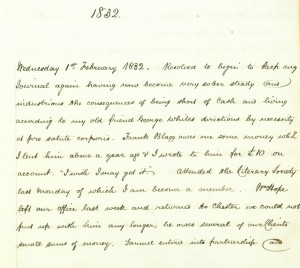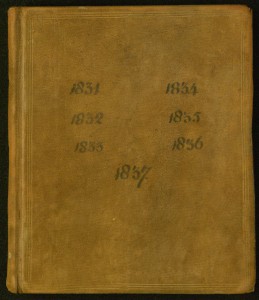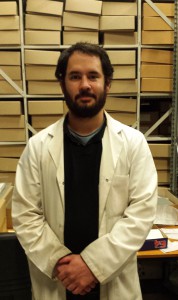March 7, 2016, by Kathryn Steenson
The life and times of a Victorian gentleman in Nottingham
This is a guest post by Matt Heald, volunteer and Document Production Assistant at Manuscripts & Special Collections.
When I began my time as a volunteer with the department of Manuscripts and Special Collections in November 2013, my first task was catalogue and summarise diaries and letters of William Parsons, solicitor of Nottingham, whose entries date from 1830 to 1881. Over a year’s volunteering later, William’s story is as intriguing as ever and offers an insight into the life and times of a Victorian gentleman.
William begins writing in 1830 as a young man of 21 years of age working with his father, a landowning solicitor of considerable social standing, as well as his younger brother Samuel in the family business Parsons and Sons. William’s diaries are used as a form of business ledger as well as an account of his busy social life. A charismatic young man from an upper middle class background, William spends much of his free time carousing with his peers, gambling, shooting and dining. The diaries uncover more than just a list of his favourite haunts however; frequent accounts of visiting brothers, grandparents, cousins and other relatives show strong familial bonds among the Parsons and Tate families. William suffers several losses during the years to come including his sister Eleanor, his grandmother, his infant son Thomas, his uncle and his dear friend Sam Roberts. Such accounts are usually accompanied by a tribute including poetry or prayers, demonstrating a flair for writing and a strong commitment to the Christian faith.
These diaries also contain significant events such as an outbreak of Asiatic cholera in 1832, reaching from Newcastle, Sunderland and Edinburgh as far south as London with many reported deaths. Entries such as this give an insight into a world in which large city communities exist in close proximity yet without the benefits of a National Health Service or medical knowledge that we expect today. In an era where tuberculosis and whooping cough are commonplace and bloodletting or leeches are still accepted cures, death constitutes a lingering theme that Victorian people had to live with every day.
Fortunately, life for William Parsons was not all about pain and misery. Located throughout the collection are several accounts of family holidays spent in Britain. These include Wales, the Isle of Man, London several times , including during the coronation of Queen Victoria (he sees the Queen and Prince Albert and even attends the same theatre production as them) and various festive events spent with his relatives and friends from Nottinghamshire, the Midlands and other areas of England. Local events are attended such as the Nottingham Goose Fair, which continues today as an annual festival, in addition to exhibitions, plays, banquets, ballroom dancing and speeches by contemporary orators such as Irish political leader Daniel “The Big Beggarman” O’Connell for instance. Much can be learned from the diaries about entertainment, popular culture and current events. For example, William was present at the hanging of Hearson, Armstrong and Beck – three men connected with the burning of Nottingham Castle during the riots of 1831. The diaries mention a boxing match involving William “Bendigo” Thompson who was something of a local legend at the time.
The Parsons collection (MS 489) comprises eight volumes of diaries, as well as letter book and a memoranda and address book owned by William and his son Frederick Parsons. They are packed with details and cataloguing them remains an ongoing process; I have since started working for Manuscripts and Special Collections but continue this task as a volunteer, as I find myself ever intrigued as to what the writings of this Nottinghamshire gentleman will reveal next.
More information about Parsons has been extracted from one of the diaries and has been compiled here.
William Parson’s diaries are available for consultation in the Reading Room at King’s Meadow Campus. They were prioritised for more detailed cataloguing due to interest from researchers looking into Extreme Weather and have also featured in our 2013 exhibition Nottinghamshire’s People. If you’d like to view this or any of our archives and rare books, please contact us to make an appointment. For more information about our holdings, please visit our website.




As a trustee of Bendigo Memorial Fund, (and with the reference to Bendigo) the diary of Parsons is a fascinating insight into a middle class person. It contrasts to to the life of Bendigo in Victorian Nottingham. It also appears that they lived to a similar age Bendigo 1811 to 1880 Parsons 1809 to 1881